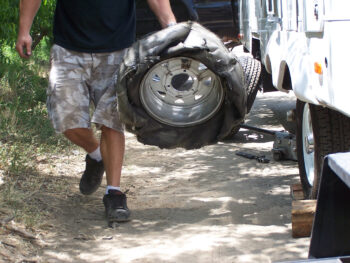

Maximum or Recommended Tire Pressure? How do I choose?
Maximum or Recommended Tire Pressure? A question often asked by RV Newbies and Old Timers alike. Proper tire inflation is crucial for optimal vehicle performance, safety, and efficiency. When determining the appropriate tire pressure, it is essential to differentiate between the maximum tire pressure listed on the sidewall and the recommended tire pressure provided by the RV manufacturer. This article clarifies the distinction between these two values and highlights the significance of following the manufacturer’s guidelines.
The Maximum Tire Pressure on the Sidewall:
The maximum tire pressure stated on the sidewall refers to the highest pressure at which the tire can safely operate. It is expressed in pounds per square inch (psi) in North America. The tire manufacturer determines this value, and it is specific to each tire model and size.
Here is an example: according to this Load Inflation Chart for Goodyear ST Tires, an ST235/85R16 tire carrying 1830lbs requires only 25psi. But, that same tire loaded to its maximum capacity of 4400lbs requires the maximum tire pressure of 110psi. For every load in between, Goodyear specifies the proper inflation pressure.
Vehicle Manufacturer’s Recommended Tire Pressure:
The recommended tire pressure provided by the vehicle manufacturer is determined by testing and engineering considerations specific to the vehicle model. The manufacturer’s recommendation primarily considers the travel trailer’s weight and sets its recommendation based on the tire manufacturer’s Load Inflation Chart. To a lesser degree, handling characteristics, ride comfort, and fuel efficiency are also considered.
You can find the proper tire inflation pressure for your specific trailer in the owner’s manual or the Data Plate on the left lower front corner of the trailer/fifth wheel.
Understanding the Difference between Maximum PSI & Recommended PSL
The maximum tire pressure mentioned on the sidewall is not always ideal for your trailer. Over-inflating or under-inflating the tires can lead to an uncomfortable ride, reduced traction, uneven tire wear, and increased vulnerability to damage from road hazards. Moreover, it may negatively impact the vehicle’s handling.
Conversely, following the vehicle manufacturer’s recommended tire pressure ensures optimal performance and safety.
Conclusion:

While the maximum tire pressure listed on the sidewall represents the tire’s safe operational limit, it is crucial to adhere to the vehicle manufacturer’s recommended tire pressure. Following the RV manufacturer’s guidelines ensures optimal performance, safety, and longevity of the tires and the travel trailer. Regularly checking and maintaining the recommended tire pressure helps to miles from your tires. Always consult the vehicle’s owner’s manual or other reliable sources for the correct tire pressure information.
You may also be interested in these articles.
Tire Speed Rating for Travel Trailers
Tire Pressure for Truck When Towing Fifth Wheel
RV Tire Maintenance Tips
How to Choose the Right Tires For Your Towable RV







